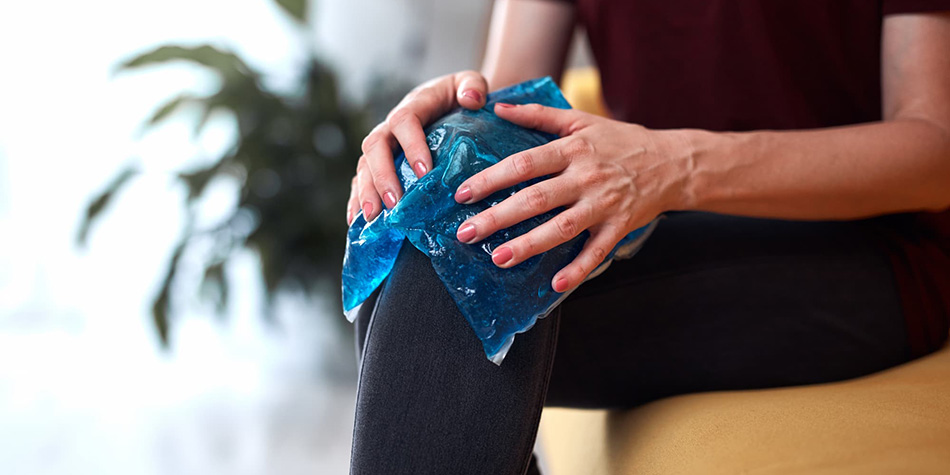
Hold an ice pack to the outside of the affected area to reduce swelling.
If you've ever had an injury, chances are you've been told to apply heat or ice to the affected area. While heat and ice are well-known remedies for minor injuries, it's not always clear when to use which. Whether you should apply heat or ice will depend on the type of injury you're treating. Both can help relieve pain and aid the healing process, but it's important to use them the right way at the right time to prevent further injury.
Why do we use heat and ice for injuries?
Most injuries cause inflammation, pain or swelling. Inflammation is your body's natural response to illness or injury, and it's an important part of the healing process. Swelling is typically the result of inflammation caused by a buildup of fluid in the tissues.
When you get an injury, ice can cool the area and gradually reduce swelling. The cold constricts blood vessels and decreases circulation to that part of the body. Ice can also reduce pain, inflammation and muscle spasms. In contrast, applying heat to an injury increases blood flow to the area, helping it heal faster. It can also provide relief from chronic pain and stiffness.
When to use ice on an injury
Commonly used to treat sports injuries — such as sprains, twists and strains — ice helps reduce swelling and inflammation. It can also ease pain temporarily by numbing the area. When blood vessels are damaged, ice helps reduce swelling by constricting them. When treating an injury with ice, it's important not to apply it for too long. Keep icing sessions to 20 minutes or less to reduce the risk of irritating the skin or causing tissue damage. Never apply ice directly to the skin — this can cause frostbite. In most cases, icing on and off for the first 48 hours after an injury is considered beneficial.
Ice or a cold compress can also help relieve dental pain, such as a toothache or swollen gums. You can hold an ice pack or compress to the outside of the affected area for a couple of minutes to numb the pain and reduce swelling.
When to use heat on an injury
Heat should be used after icing when the swelling has gone down. Applying heat to an injury increases blood flow to the area and helps facilitate the healing process. But, if you apply heat too soon after an injury, it can cause additional swelling by increasing blood flow too much. Heat dilates (widens) blood vessels and is best used on larger muscle groups such as the calves and hamstrings, or for muscle spasms not caused by an injury. Large muscle groups benefit from increased blood circulation because it provides oxygen and other nutrients to the tissues, promoting recovery.
Heat also helps soothe tight muscles and relieve stiffness or pain from chronic conditions such as arthritis or fibromyalgia. Taking a hot shower or bath (between 92 and 100 degrees), sitting in a sauna or applying a heating pad to an affected area can help relax tight muscles and alleviate pain. You can apply heat for up to 30 minutes, but you should discontinue use if the skin becomes irritated or painful. Like with ice, heat should never be applied to an open wound or directly to skin. Avoid applying heat to burns, infections or new injuries, since it can draw more heat to the area and slow down healing.
When to alternate between ice and heat
Icing at the initial onset of an injury is typically recommended to help with the pain. After that, it's generally considered beneficial to alternate between heat and ice until pain subsides and swelling goes down. Use heat in the morning to warm up stiff muscles and ice in the evening to reduce swelling or pain associated with movement throughout the day.
Contrast therapy — alternating between cold and heat — works by constricting and expanding the blood vessels to help push inflammation away from the affected area. Ending a hot-cold therapy cycle with ice keeps the blood vessels narrow to prevent inflammation from coming back. But if you're not careful, you could end up making the injury worse. Heat and ice can both cause tissue damage if applied for too long or directly to the skin, so it's important to practice caution and seek guidance from a medical professional before starting contrast therapy.
When to seek medical attention
Depending on the severity of your injury, ice or heat may be enough to aid the healing process. But if the pain doesn't go away after a couple of days, or if it changes or worsens, talk to your doctor as soon as possible. You should also seek medical attention if you have an injury that requires stitches or if you are experiencing restricted joint movement, as these are typically signs of more serious injuries.
$webqFacilityNumber
Need a Physician?